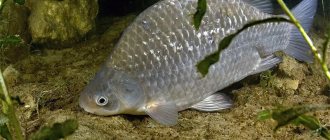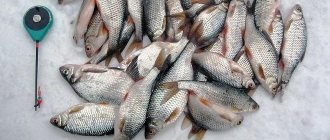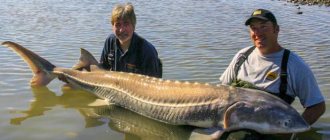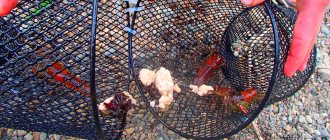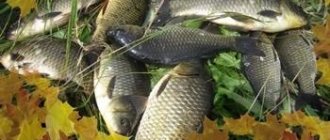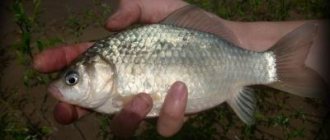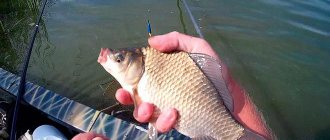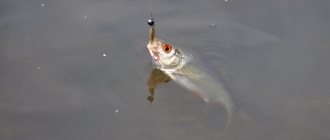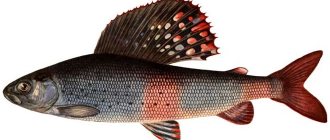Crucian carp is a freshwater fish. It lives in many rivers and lakes of our country. Its color depends on its habitat. There are two types: gold and silver crucian carp.
In some cases, it can grow up to half a meter and gain weight over 3 kilograms. Fishing is exciting and interesting in places. Where it is effectively caught, you should try different fishing methods.
Lure for catching crucian carp
Lure fishing is especially important in the spring. After wintering in his hibernation pit, during high water he goes out to catch his breath in the flooded meadows.
In the northern regions such places are called Mari. The parking site can be easily seen by the movement of water and the release of bubbles when breathing. The crucian carp is resting and basking in the sun; it is at this time that you should start fishing for it.
When choosing gear, you need to use a spinning rod or a fishing rod with a spinner attached to its end. The fishing process takes place by throwing bait at the place where the fish is visible. After which you should expect a bite and sharply hook the prey.
Let's celebrate! Many experienced fishermen recommend using CONDOR 38 gram spoons, the so-called spoons.
Also experiment with different types of bait, such as spinners.
Tackle
A variety of gear is used to catch crucian carp in winter. In non-freezing reservoirs, a five-meter light float rod is needed. When fishing from ice, use a winter fishing rod, light and with a thin line so as not to spook the fish. But the line should be thicker than when fishing for roach, from 0.13 to 0.16 millimeters in diameter. During the dry winter period, the fishing line is usually changed to a thinner one. The nod movements on a winter fishing rod should be active, but not sharp, otherwise the fish will get scared and it will be impossible to catch it. For convenience, the fishing rod should be placed on a stand, especially if passive fishing is expected in a bunch of holes using a large number of fishing rods.
When fishing in the current, use a rocker with two hooks. But for ice fishing in reservoirs without a current, such gear is not suitable. Extra hooks allow you to experiment with baits. For example, you can put dough on one hook and a piece of worm on the other. The fisherman notices which bait bites best on that day, and in the second half of fishing he fishes only with this bait.
Read: Fishing in winter. Beyond the river
In strong currents, they try to catch crucian carp using donks with a free nod. The donka should be conveniently located. For such fishing, you should be patient, since experience does not come immediately and not on the first fishing trip. You should consult with experienced fishermen so that experiments with this gear bring results.
Other baits for crucian carp fishing
Boyles
- Such modern bait as boilies has a great advantage.
- Only large specimens can bite on such a bait.
- Dense balls are impregnated with special flavoring compounds and can remain in water for a long time.
- Depending on the nature of the chosen fishing spot, floating or sinking boilies are used.
- They hook onto the hook without any difficulty.
Silicone baits
- Artificial species that imitate various types of bait (larvae, grasshoppers, worms).
- They arouse genuine interest among many species of fish.
- The resemblance to many larvae or insects attracts both predators and peaceful fish.
- In reservoirs you should try to catch fish using these types of baits.
- You should take into account weather conditions under which there may be no bites at all. Or aquatic inhabitants will give preference to another type of bait.
Baits of plant origin
- Application in the summer is especially effective.
- Corn is a vegetable bait and will always arouse the interest of large crucian carp. The main advantages are stability on the hook and cuts off the bite of small fish.
- Steamed peas are dense in structure and ideal for ingestion by fish. Attracts with its appearance.
Many fishermen are creative when preparing dough.
Taking into account the local habits of the fish.
- Semolina is used to prepare mash.
- You can mix mastyrka from pea flour and semolina.
- To prepare mamalyga, corn and rye flour are mixed. The dough has a soft consistency and an appetizing smell.
Steamed pearl barley is indispensable when catching crucian carp. This is an indispensable delicacy for fish of the carp family.
Animal bait
Crucian carp prefers these species in spring and autumn. Since he has an increased need for protein. Particularly in demand are maggots, dung worms and bloodworms.
If possible, you should take three baits at once when fishing to increase the chances of a larger catch. Determine your preferred bait. A sandwich made from several larvae attached to a hook shows good results.
Flavors
To increase the catch, a huge range of different flavoring additives are used, which attract many species instinctively:
- Starting from sweet aromas: honey, tutti-frutti, strawberry, vanilla.
- Finishing with the smells of smoked fish, shrimp, crab.
- And in the middle you can add flavors of corn, herbs, peanuts, garlic and a wide variety of other flavors.
- The most famous is sunflower cake.
- Some anglers use regular cat and dog food with great success.
Interesting notes about the crucian bite
It is a fascinating sight to watch the movement of the float on the water. Small twitches, moving to the side, diving, lifting. When to hook? And for this you need to have at least some idea of what is happening with the bait at the bottom. On one of the sites I found something quite interesting and informative about biting crucian carp.
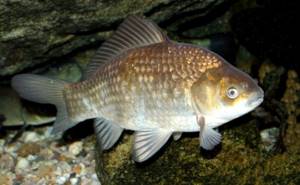
Every angler planning to fish for crucian carp should know how crucian carp bite. This is especially true for novice fishermen taking their first steps in this interesting activity. The thing is that the crucian bite is fundamentally different from the bites of other fish. She is very “gentle” and careful. This is not a perch bite when the float suddenly goes into the water - sometimes even with small splashes. And not the bite of the carp, which sucks up the bait and is caught on its own. A crucian bite usually looks like this: the float rises above the water and begins to slowly swim to the side. In this case, the moment of cutting should be chosen most carefully. If you hurry, the crucian carp will not have time to swallow the bait. And if you are late, he will simply “gnaw” the hook and spit it out. It is quite obvious that the skill of hooking crucian carp on time will manifest itself quickly - as your hand “gets full.” Subsequently, you don’t have to think about how the crucian carp bites anymore. However, in our era of high technology, the fisherman is sometimes still tormented by the desire to see in detail - what does the crucian carp do with the bait when biting? And how does he suck it so much that the float begins to float on the surface, slightly falling on its side, and yet the moment of hooking must be determined in time?
Underwater photography and video shooting, as well as visual monitoring carried out by specially trained divers (in all seriousness!) made it possible to shed light on these issues.
Crucian carp bite
How does crucian carp bite? It’s funny, but his entire bite, despite the fact that it doesn’t last very long, can be divided into several stages or phases. Let's look at each of them in more detail.
First phase: "discovery"
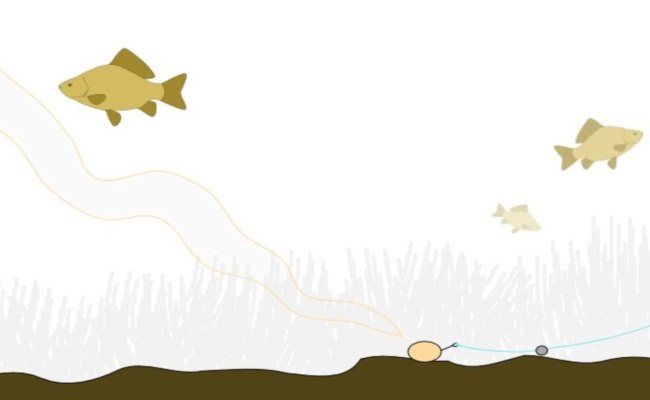
It all starts with the fact that the crucian carp’s olfactory organs (and he’s an excellent sniffer, you know!) register the presence of a small amount of dissolved nutrients in the water. The fish immediately “switches” its behavioral model and begins to purposefully search for the source of the smell. She “walks in circles” and “sniffs”, clearly defining the place where the concentration of molecules of dissolved substances will be maximum. And after some time (quite quickly) he finds a seductively smelling object.
Second phase: “tasting”
Yes, but the bait thrown to the bottom smells not only of the dough that is attached to the hook, but also of the hook itself, as well as the fisherman’s hands. The crucian carp senses this whole “bouquet”, detects the presence of odors unnatural for the aquatic environment, and slightly suspects a catch. Before grabbing the bait, he tastes it. He takes it by the edge, slightly lifting it above the bottom. It is at this moment that the float begins to rise. But it’s too early to hook, because the hook is not yet in the crucian’s mouth.

Sometimes a crucian carp, after “playing around” with the bait for a while, does not swallow it, but throws it away and leaves. Most often, this behavior is observed at a time when the fish are inactive. But it also happens that the cause of an abandoned bait is a too heavy sinker lying on the bottom.
Third phase: “absorption” (the moment of hooking the crucian carp)

But now the crucian carp is convinced that the object of his interest is quite edible and even tasty. He begins to absorb the bait. If it is large and does not fit into his mouth, he plucks it piece by piece. And while the crucian carp “chews” pieces, the bait falls to the bottom every time. At the same time, the float either rises or again takes its original position (twitches).
When there is a piece left that can fit in the crucian carp’s mouth, it immediately ends up there. The float finally stands up (or even falls to one side). Without a “support”, the role of which was played by the sinker-support, the float begins to float on the surface. The crucian carp only contributes to this with its movements.
Fourth phase: “spitting out”

But suddenly the crucian carp sensed a hard, inedible object in the tasty morsel. It can also prick itself on the hook's tip. The fish immediately spits out the bait. If the fisherman didn’t have time to hook, that’s it. He can’t see a freshly pecked crucian carp in the cage. The float returns to its original position, after which it will not budge until the fisherman realizes that the bait has been eaten, and now you won’t get a bite - until you replant it.
However, it is quite obvious that the only sure way to avoid the last phase of the crucian bite is not to catch the crows and hook them on time.
Bait for crucian carp: recipes
In fishing stores we are offered a wide range of baits for crucian carp, from domestic and foreign manufacturers. It may not be useful for the fisherman in all cases. Professional fishermen prefer to cook it themselves, using proven recipes.
Makukha and millet
- Take a cauldron, add 2 cups of water to it and bring to a boil.
- Pour in 1 cup of millet, cook, stirring lightly for about 3 minutes, so that the millet is not too liquid, but semi-dry.
- Add 1 cup of flour and stir thoroughly. The complementary foods are ready.
Catchy porridge for carp and crucian carp
- You need half peas, millet and corn grits.
- Pour 6 glasses of water into a cast iron pot and wait for it to boil.
- Throw in 1 cup of pre-soaked peas and cook for 30 – 35 minutes, stirring occasionally. Add a spoonful of sugar.
- Add 2 cups of millet and stir. We wait 10 - 15 minutes, do not let the porridge burn.
- Add 2 cups of corn porridge. Cook for 10 minutes, evaporating the water until smooth. Let cool.
- Add flavorings if desired. Ready.
Favorite bait for peaceful fish
- Boil 2 cups of millet.
- Grind the seeds and crackers to 1:1 cup flour, prepare 1 cup of rolled oats.
- Mix the resulting mixture thoroughly, adding 50 grams of vegetable oil.
- Crush 1 head of garlic and add to the resulting mixture, kneading thoroughly. Everything is ready for use.
Lure
Some fishermen believe that crucian carp do not need to be fed at all, but this is not entirely true. Indeed, on some days after feeding, the bite of crucian carp gets worse, but you still shouldn’t give it up. There is no ideal feeding composition, since crucian carp have an unpredictable temperament. But one thing is true: bait should be thrown into the hole in a very moderate amount, only so that the fish comes to this place. And if you throw a bunch of food, it will become so full that it will be almost impossible to catch it with a hook or jig.
Feeding should be thrown into the hole immediately after drilling and then a little at a time 3-4 times during fishing. Homemade fertilizers made from semolina with garlic and vegetable oil have worked well. Or you can feed them with store-bought food that contains the obligatory cake. It has been noticed that food for crucian carp from one pond is not suitable for fish from another pond or lake due to the capriciousness of the fish. For some reason, some crucian carp love millet, others love corn supplements. Therefore, to attract “bast eggs” with the help of fertilizing, there are also a lot of opportunities for experimentation by trial and error. Northern fishermen like to feed crucian carp with oatmeal mixed with egg powder. Well, it goes without saying that feeding should be done at home before going fishing. Recipes for winter food to attract crucian carp are as simple as possible. These fish do not like strange food and strong odors, so you should not use flavorings.
Reviews from fishermen
There have been cases when crucian carp become a predator in some lakes. For many years now I have been fishing for medium-sized crucian carp in a familiar reservoir, but avid fishermen catch some specimens there up to 3 kilograms, only with live bait. So sometimes he’s enough for a spinner. Grade:
Anton
I can say with firm confidence that I myself have personally seen how they catch not carp, but crucian carp using silicone and hard baits. It bites intensely, and they pull out heavy crucian carp. Grade:
Gregory
A well-chosen place for fishing and aromatic bait is the key to success for a rich catch. Avid fishermen do not return with an empty fishnet. They know in advance where and when the fish will bite. Then you will get a normal result. Grade:
Sergey
We went fishing for crucian carp, but the weather was bad. He suddenly stopped pecking. We tried a lot of baits and all in vain. We were unlucky this time, although we had caught more than one bucket at this place before. And there were some good specimens. Grade:
Ilya
I have been interested in fishing for a long time. I know many productive fishing spots on rivers and lakes. I would like to note that the specifics of fishing are different everywhere. And there are significant differences when biting one type of fish in different bodies of water. Grade:
Semyon
For people who are passionate about fishing, fishing for crucian carp seems to be an important and exciting way to spend personal time and relaxation.
Crucian carp fish is common in Russian regions and regions. And some call it trash fish. In terms of taste, it is in no way inferior to other types and even superior.
Let's celebrate! It is quite strong and unpretentious in its habitat. It quickly gains live weight in natural and artificial conditions. It reproduces intensively and for some layers, it is considered the main object of fishing and is caught throughout the year.
Peculiarities of crucian carp biting by season
In the spring during spawning, it is distinguished by its mobility. With the onset of warmer months, they gather in large flocks in search of habitat. They reach dams and spills where they spawn. During the warmer months, they return to the areas where they previously lived.
The spawning season is stormy - grass is constantly moving under the banks, which indicates that the fish are laying eggs
The spawning season is preceded by a pre-spawning feast, when individuals are in search of food.
It should be noted that it is not at all difficult to catch such an individual in the spring. For successful fishing you only need good weather, which would last for a couple of days.
In the summer , individuals become unpredictable and this is probably due to the fact that in the summer they prefer to eat plant foods. Since there are always quite a lot of plants in the reservoirs in which crucian carp live, it is difficult to please its taste preferences.
In the summer, he spends his days buried headlong in the mud, and only from late evening to early morning does he come to the shore to feast on plants.
Winter crucian fishing
In autumn, the bite deteriorates significantly and, perhaps, this is due to the fact that in autumn the fish do not have much of an appetite. The flocks travel less and less often closer to the shore, stay at significant depths and again switch to animal food.
In winter, the situation with catching in small reservoirs comes to naught, since small water bodies freeze almost to the very bottom.
But the situation with deep reservoirs is not so dire, since it continues to actively feed in them. During the winter months, he chooses places with warmer water.
From all that has been said, only one conclusion can be drawn: it will be possible to catch crucian carp in water bodies all year round, you just need to choose the right place.

